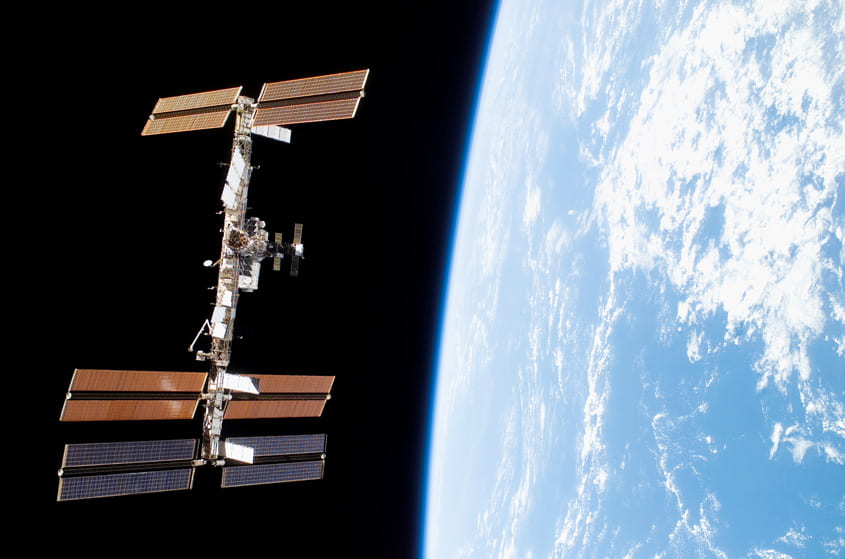
SJSU bioinformatics students helped NASA scientists better understand how living organisms react to life on the International Space Station compared to Earth. Image courtesy of NASA.
How does space travel impact the human body? That’s a question scientists are still trying to answer. This summer, they got a little closer to the answer, thanks to some extra help from San José State University students.
A cohort of biology and computer science undergraduate students were the first to participate in San José State’s new bioinformatics internship program with NASA, developed by two SJSU College of Science faculty: Philip Heller, assistant professor of computer science, and Bree Grillo-Hill, assistant professor of biology.
Equipped with knowledge from their SJSU biology and computer science courses — plus training from a bioinformatics bootcamp — six students joined NASA’s GeneLab project. They helped analyze and interpret publicly available data that revealed the RNA of different organisms, including humans, plants, insects and mice, in order to compare how those organisms responded to life on the International Space Station compared to Earth. The internship began in June and ended in August.
“The goal was to gain insights into the biological processes that degrade astronauts’ health in microgravity and other stressful conditions,” explained Heller. “These insights will drive decisions about lowering astronaut health risks, so the implications for science are profound.”
For example, Evelyn Wong, ’21 Biology, analyzed data to help NASA researchers better understand how and if cancer could be a risk following space travel.
“Astronauts are exposed to radiation when traveling to space, which makes them likely candidates for developing cancer later in life,” she explained. “I studied samples that might be able to help identify that possibility for developing cancer in the future.”
Wong said she’s not a natural programmer, so the internship offered her an opportunity to gain new data processing skills while putting her biology knowledge to use. Her hard work paid off: After her internship wrapped up in August, Wong began working as a full-time research associate contracted by Blue Marble Space Institute of Science to work with NASA.
That’s the kind of success Heller was hoping his students would achieve when he developed the internship. Bioinformatics is an increasingly important field, he noted. San José State offers a minor in bioinformatics as well as a master’s degree.

Publicly available data gathered from preserved tissues such as those seen here, archived at the NASA Ames Research Center, were analyzed and interpreted with the help of SJSU bioinformatics students. Image credit: NASA/Dominic Hart
Grillo-Hill emphasized that the experience can give students an edge in job searches and graduate school applications.
“Many cutting-edge projects in biology research require generating, managing and analyzing large data sets,” she explained. “Our bioinformatics minor teaches students the tools to do this, and internships give them the opportunity to practice these skills on real data sets.”
With NASA’s Artemis program to land humans — the first woman and first person of color, specifically — on the moon in 2024, “the urgency is high” to better understand how humans respond to space travel, Heller emphasized.
He hoped to create a program that would allow both SJSU and NASA to reap the benefits. SJSU could supply a steady stream of talented students interested in bioinformatics, and the next generation of scientists could gain valuable first-hand interdisciplinary experience, he said.
While this isn’t the only opportunity SJSU students have to intern with NASA — the College of Engineering, for example, helps place aerospace engineering students into internships with the agency — it’s the first chance for SJSU students interested in bioinformatics.
To make sure students were ready to hit the ground running, Heller, in collaboration with NASA GeneLab and Universities Space Research Association, kicked off the program with a five-day intensive bootcamp that acquainted students with NASA’s processes and goals and provided a deeper understanding of the field.
Kevin Truong, ’22 Computer Science, found the experience of working in an interdisciplinary environment with NASA scientists eye-opening.
“Working in bioinformatics gave me the opportunity to explore different fields and to learn things I didn’t know — and that I’ll likely never understand. And that’s OK if there is someone else on your team who can explain it. Sometimes, I will be the one to explain things to someone else.
“It’s a fascinating field and can be challenging, but in the end you get to create greater things.”
Heller emphasized that “even if the interns don’t become NASA scientists, they will gain training and experience in techniques that are commonly used in biotech, so we believe their long-term career experiences will be greatly enriched.”
Aeowynn Coakley, ’21 Biology, already feels that her future as a research scientist has been influenced by the experience.
“Whatever I do next, I want to work with an interdisciplinary team. You can go so much further and understand so much more working together that way,” she said.
“Bioinformatics is a really important tool to make meaningful inferences about data being collected,” she continued. “We are in an era of big data, and there’s so much biological information out there and so many scientists working siloed as they delve into this data. Through bioinformatics, we can make really meaningful contributions to the field by introducing an interdisciplinary perspective.”
Learn more about San José State’s MS in Bioinformatics and minor in Bioinformatics.
